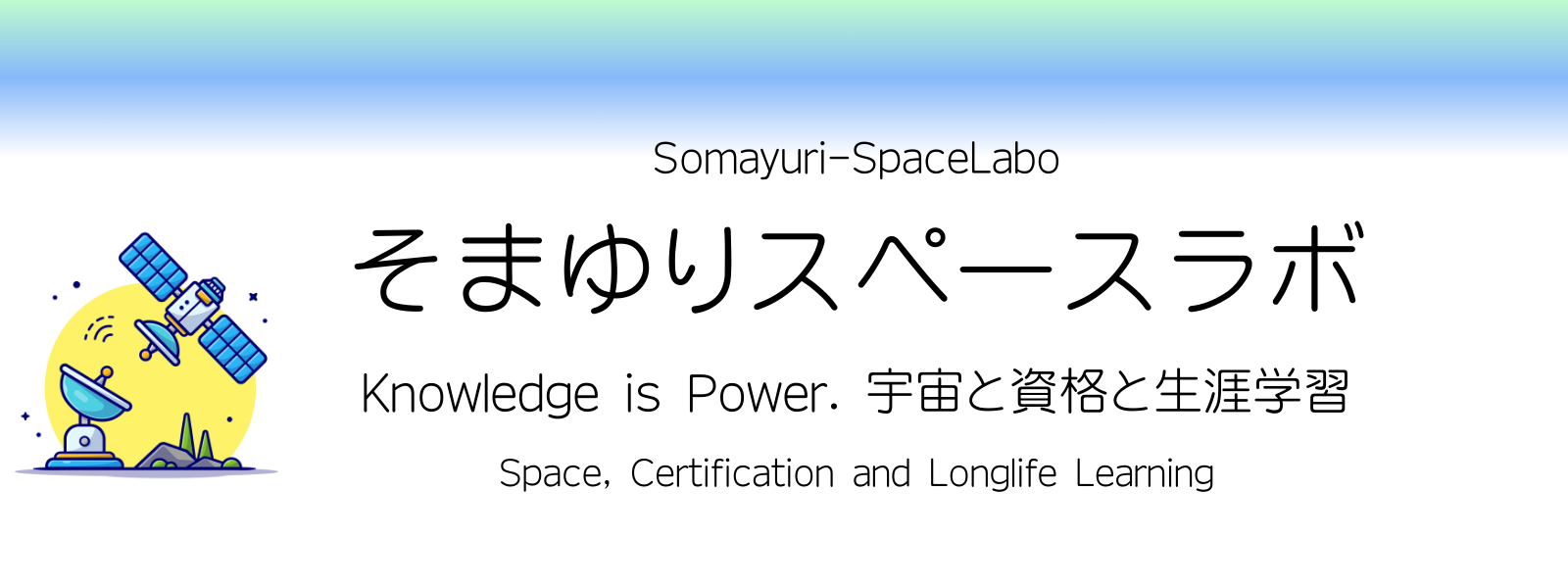The 7th edition of the PMBOK Guide was published in 2021, and it is no exaggeration to say that there have been dramatic changes from the 6th edition of PMBOK to the 7th edition.
The contents will be quite shocking for those who have been studying project management based on the 6th edition or those who earned the PMP before the 7th edition was published.
I also studied PMBOK using the 6th edition and earned the PMP certification in 2020.
Since then, I have been carrying out project management activities based on the 6th edition of PMBOK, when I was renewing the PMP I studied the 7th edition and was astonished by the transformation.
In this article, I will discuss what has changed from the 6th edition to the 7th edition of PMBOK.
The 8th edition of PMBOK is scheduled to be released in 2025, so if you haven’t yet checked out the changes in the 7th edition, this is a must-read.
What you can learn by reading this article
- What is PMBOK?
- What is the difference between PMBOK 6th & 7th edition?
- From Process-Based to Principle-Based
- [6th edition] the 10 Knowledge Areas
- [6th edition] the 5 Process Groups
- [7th edition] the 12 Principles of Project Management
- [7th edition] the 8 Project Performance Domains
- From Process-Based to Principle-Based
- What is Tailoring
Please refer to the article below about PMP certification.
(Below is Japanese page only. English page is under construction.)
- What is PMBOK?
- What is the difference between PMBOK 6th & 7th edition?
- From Process-Based to Principle-Based
- Project Management Structure
- [PMBOK 6th edition] the 10 Knowledge Areas
- 1) Project Integration Management
- 2) Project Scope Management
- 3) Project Schedule Management
- 4) Project Cost Management
- 5) Project Quality Management
- 6) Project Resource Management
- 7) Project Communications Management
- 8) Project Risk Management
- 9) Project Procurement Management
- 10) Project Stakeholder Management
- [PMBOK 6th edition] the 5 Process Groups
- [PMBOK 7th edition] the 12 Principles of Project Management
- [PMBOK 7th edition] the 8 Project Performance Domains
- [PMBOK 6th edition] the 10 Knowledge Areas
- A new chapter dedicated to tailoring
- Models, Methods, Artifacts and utilizing Digital Content Platform
- Comparison of table of contents for PMBOK 6th and 7th editions
- Conclusion
What is PMBOK?
PMBOK is “the Project Management Body of Knowledge” and is a systematically organizes techniques and know-how related to project management.
The American non-profit organization PMI (Project Management Institute) has issued a guidebook called the “PMBOK Guide.”
PMBOK was first issued in 1987, and the first edition was published in 1996 as the PMBOK Guide.
Contents are updated about once every four years, and the latest PMBOK Guide is the 7th edition (published in 2021).
It is now used around the world as the de facto standard for project management.
PMBOK is a compilation of currently possible project management systems derived from past project management best practices, and will be updated over time.
1996, the First edition
2000, the Second edition
2004, the Third edition
2008, the Fourth edition
2012, the Fifth edition
2017, the Sixth edition
2021, the Seventh edition
2025, the Eighth edition planned
What is the difference between PMBOK 6th & 7th edition?
There are three major changes between the 6th and 7th editions of PMBOK.
I will discuss them in order below.
- From Process-Based to Principle-Based
- From “the 10 Knowledge Areas of 6th edition” to “the 8 Project Performance Domains of 7th edition”
- From “the 5 Process Groups of 6th edition” to “the 12 Principles of Project Management of 7th edition”
- A new chapter dedicated to tailoring
- Models, Methods, Artifacts and utilizing Digital Content Platform
- From “Tools and Techniques of 6th edition” to “Models, Methods, Artifacts of 7th edition”
From Process-Based to Principle-Based
This is the biggest change and it’s here that will shock you the most.
In the 6th edition of PMBOK, the structure was organized into “the 10 Knowledge Areas” and “the 5 Process Groups (49 Processes)”, but in the 7th edition, this has been changed to “the 12 Principles” and “the 8 Project Performance Domains”.
That is because various project styles have emerged these days, with Agile at the forefront, and the description of waterfall-type projects that was the basis until the 6th edition is no longer sufficient to describe modern projects.
Therefore, rather than rigidly fixing the process as in the previous 6th edition and providing how-to instructions for each process, this edition clearly defines the areas in which performance can be demonstrated based on clearly defined principles, and by showing the specific activities and behavior of a project manager in each area, it can be said that it is organized in a way that allows it to flexibly respond to any type of project.
“the 10 Knowledge Areas” and “the 5 Process Groups” of 6th edition
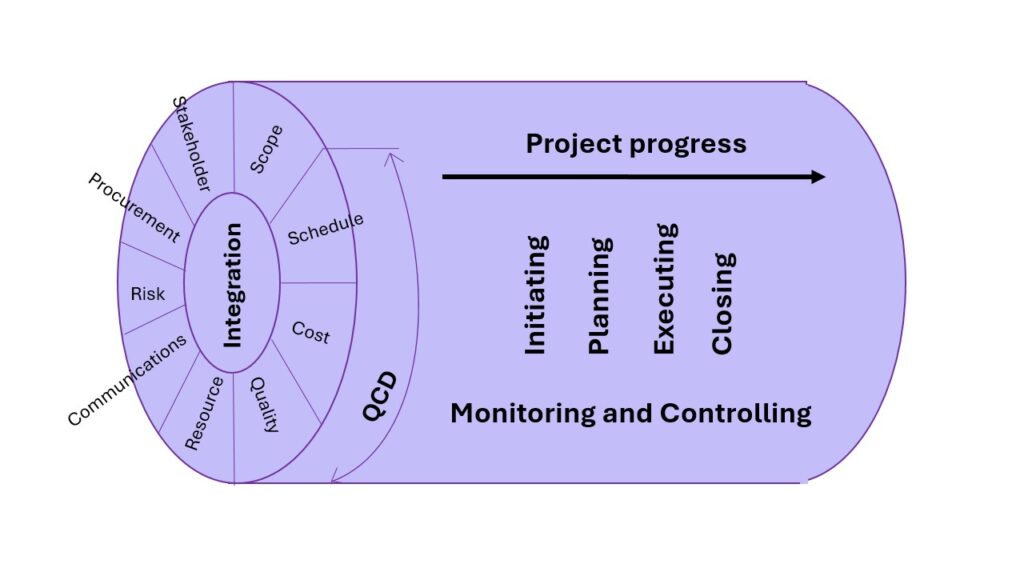
“the 12 Principles of Project Management” and “the 8 Project Performance Domains” of 7th edition
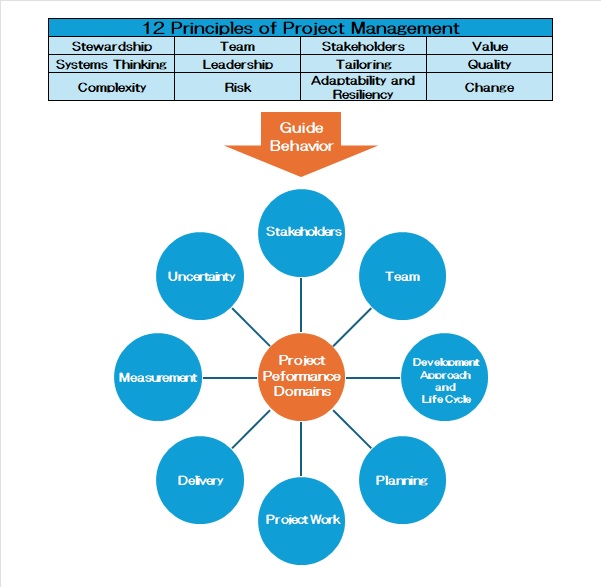
Project Management Structure
“The 10 Knowledge Areas” in the 6th edition of PMBOK correspond to the “the 8 Project Performance Domains” in the 7th edition.
In addition, “the 5 Process Groups” of the 6th edition are said to correspond to “the 12 Principles of Project Management” in the 7th edition.

It may seem a little strange that the “Process” in the 6th edition of PMBOK corresponds to the “Principles” in the 7th edition, but while in the 6th edition, the “Process” is defined as “when to carry out” the activities in the “10 Knowledge Areas,” in the 7th edition, the “Principles” are “always applied” to the activities in the “8 Project Performance Domains,” which makes sense in the sense that it ensures flexibility for a development approach of the project.
“the 10 Knowledge Areas” and “the 5 Process Groups” of 6th edition
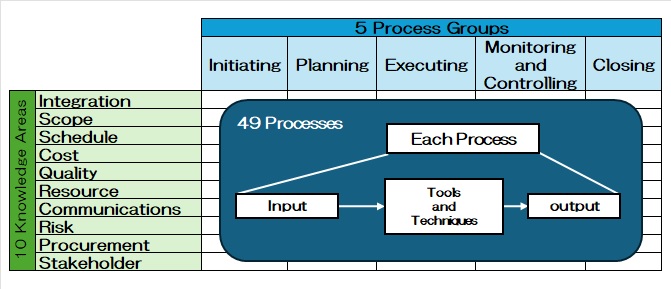
“the 12 Principles of Project Management” and “the 8 Project Performance Domains” of 7th edition
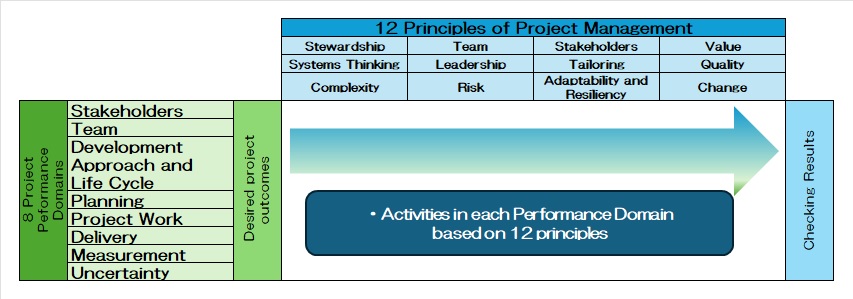
[PMBOK 6th edition] the 10 Knowledge Areas
In the PMBOK 6th edition, the knowledge required for project management is divided into 10 domains, which are defined as the 10 Knowledge Areas.
1) Project Integration Management
This is the area that decides the overall policy of the project and adjusts and manages the goals and processes. It is positioned to integrate the other nine knowledge areas and manage the whole project.
2) Project Scope Management
This is the area that defines the scope of the project, the deliverables and tasks required to make the project successful, and increase the likelihood of achieving the project goals.
3) Project Schedule Management
This is the area that can manage the project schedule to make the project a success and use time to improve the productivity.
4) Project Cost Management
This is the area that properly estimates, sets and manages the costs of the project.
5) Project Quality Management
This is the area where project processes and the quality of project deliverables are managed.
6) Project Resource Management
This area involves procuring and managing human resources and material resources to ensure the success of the project, and assembling a team that can carry out the project.
7) Project Communications Management
This area is managed to ensure clear, safe and open communication with stakeholders.
8) Project Risk Management
This is the area that manages the risks that may arise as the project progresses.
9) Project Procurement Management
This area manages the procurement of services and products required as project work progresses.
10) Project Stakeholder Management
This involves identifying stakeholders and their interests in the project, engaging with them throughout the project’s life cycle, responding to their concerns or questions promptly, and keeping them informed about the progress made toward completion.
[PMBOK 6th edition] the 5 Process Groups
The PMBOK 6th edition classifies the flow of a project from initiation to completion into five process groups and defines each one.
1) Initiating
This is the process of getting authorization before officially starting a project.
Clarify the objectives, goals, budget, and expected outcomes and develop a project charter.
2) Planning
This is the process of developping the plans necessary to accomplish the project’s objectives.
Project planning as a process is output oriented. It is concerned with deciding in advance what, when, how, and who will take the necessary actions to accomplish established objectives.
3) Executing
This is the process of procuring the necessary human and material resources and actually implementing all the other plans from the previous process group.
4) Monitoring and Controlling
This is the process where the project manager assesses the overall performance of the project and makes necessary changes to keep it on track or to get back on track.
5) Closing
This is the process of finalizing the project when objectives are met and is often led by the project manager, who will close out the project, make and review conclusions and formally archive any necessary project details.
[PMBOK 7th edition] the 12 Principles of Project Management
The 7th edition of PMBOK identifies project management principles that guide the behaviors and actions of project professionals and other stakeholders who work on or are engaged with projects
It’s not a rule, just a guideline.
1) Stewardship
Stewards act responsibly to carry out activities with integrity, care, and trustworthiness while maintaining compliance with internal and external guidelines.
They demonstrate a broad commitment to financial, social, and environmental impacts of the projects they support.
2) Team
Project teams are made up of individuals who wield diverse skills, knowledge, and experience. Project teams that work collaboratively can accomplish a shared objective more effectively and efficiently than individuals working on their own.
3) Stakeholders
Engage stakeholders proactively and to the degree needed to contribute to project success and customer satisfaction.
4) Value
Continually evaluate and adjust project alignment to business objectives and intended benefits and value.
5) Systems Thinking
Recognize, evaluate, and respond to the dynamic circumstances within and surrounding the project in a holistic way to positively affect project performance.
6) Leadership
Demonstrate and adapt leadership behaviors to support individual and team needs.
7) Tailoring
Design the project development approach based on the context of the project, its objectives, stakeholders, governance, and the environment using “just enough” process to achieve the desired outcome while maximizing value, managing cost, and enhancing speed.
8) Quality
Maintain a focus on quality that produces deliverables that meet project objectives and align to the needs, uses, and acceptance requirements set forth by relevant stakeholders.
9) Complexity
Continually evaluate and navigate project complexity so that approaches and plans enable the project team to successfully navigate the project life cycle.
10) Risk
Continually evaluate exposure to risk, both opportunities and threats, to maximize positive impacts and minimize negative impacts to the project and its outcomes.
11) Adaptability and Resiliency
Build adaptability and resiliency into the organization’s and project team’s approaches to help the project accommodate change, recover from setbacks, and advance the work of the project.
12) Change
Prepare those impacted for the adoption and sustainment of new and different behaviors and processes required for the transition from the current state to the intended future state created by the project outcomes.
[PMBOK 7th edition] the 8 Project Performance Domains
A project performance domain is a group of related activities that are critical for the effective delivery of project outcomes. There are 8 Project Performance Domains.
1) Stakeholders
The Stakeholder Performance Domain addresses activities and functions associated with stakeholders.
2) Team
The Team Performance Domain addresses activities and functions associated with the people who are responsible for producing project deliverables that realize business outcomes.
3) Development Approach and Life Cycle
The Development Approach and Life Cycle Performance Domain addresses activities and functions associated with the development approach, cadence, and life cycle phases of the project.
4) Planning
The Planning Performance Domain addresses activities and functions associated with the initial, ongoing, and evolving organization and coordination necessary for delivering project deliverables and outcomes.
5) Project Work
The Project Work Performance Domain addresses activities and functions associated with
establishing project processes, managing physical resources, and fostering a learning environment.
6) Delivery
The Delivery Performance Domain addresses activities and functions associated with delivering the scope and quality that the project was undertaken to achieve.
7) Measurement
The Measurement Performance Domain addresses activities and functions associated with assessing project performance and taking appropriate actions to maintain acceptable performance.
8) Uncertainty
The Uncertainty Performance Domain addresses activities and functions associated with risk and uncertainty.
A new chapter dedicated to tailoring
Tailoring is the deliberate adaptation of the project management approach, governance, and processes to make them more suitable for the given environment and the work at hand.
In short, it is the activity of adapting the methodology outlined in PMBOK to better suit the circumstances of the project.
Tailoring is included as an additional consideration at the beginning of each knowledge area in the PMBOK 6th edition as a way to help project teams think about how to tailor their approach to project management, but in the 7th edition it has been expanded and consolidated into a chapter dedicated to tailoring.
Models, Methods, Artifacts and utilizing Digital Content Platform
The PMBOK 6th edition described the tools and techniques used in project management, including when (in which process group) and how to use them, but the 7th edition only introduces the models, methods, and products, and instructions on how to use them are published on a website (PMI standards+ Digital Content Platform).
As a result, the number of pages in the PMBOK Guide itself has been reduced by more than half, from approximately 770 pages in the 6th edition to approximately 370 pages in the 7th edition.
PMI standards+ Digital Content Platform allows real-time access to a constantly updated body of knowledge, and also allows the downloading of templates and other materials.
Access to PMI standards+ Digital Content Platform requires a fee (PMI membership registration or subscription).
PMI standards+ Digital Content Platform (sample image)
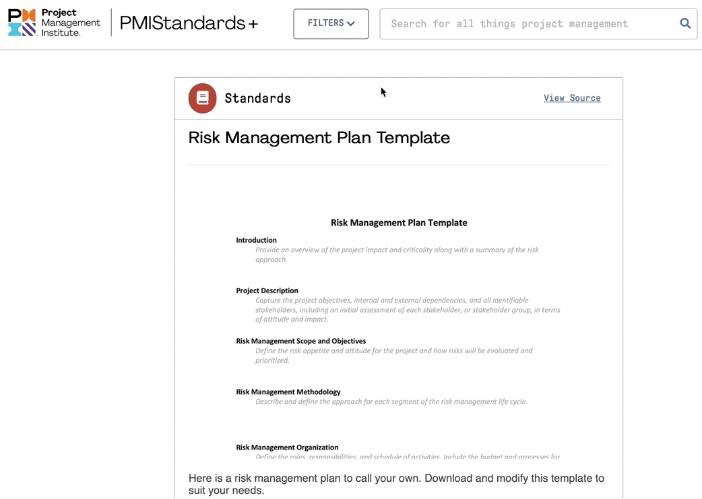

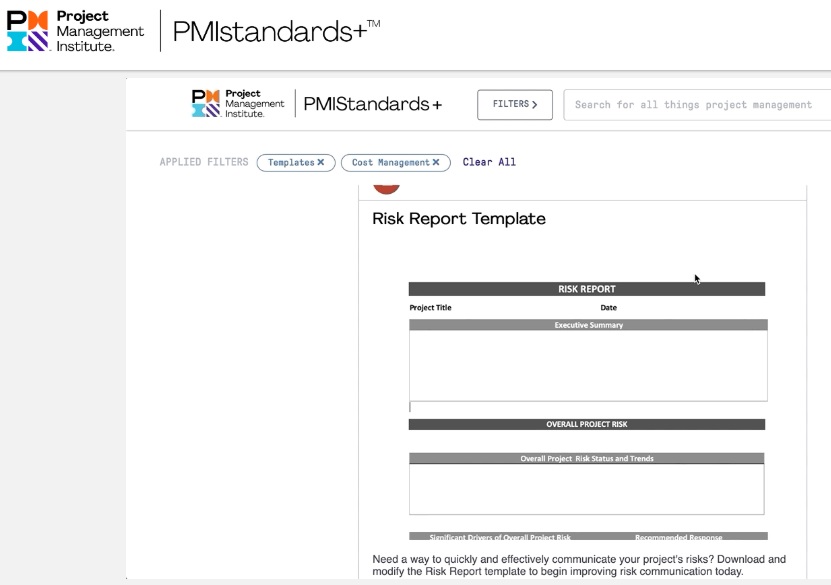
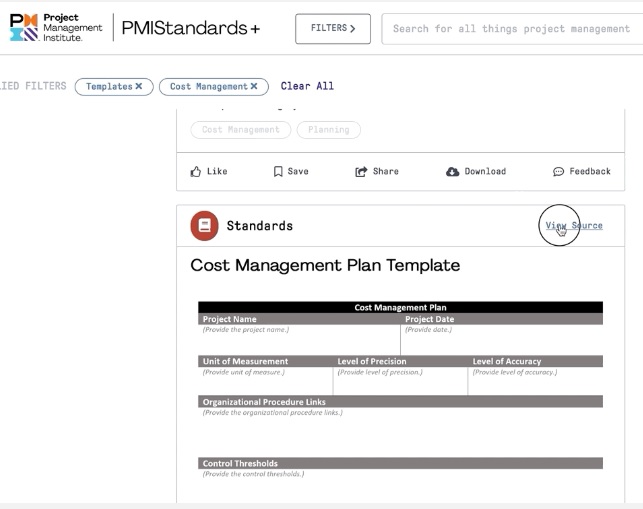
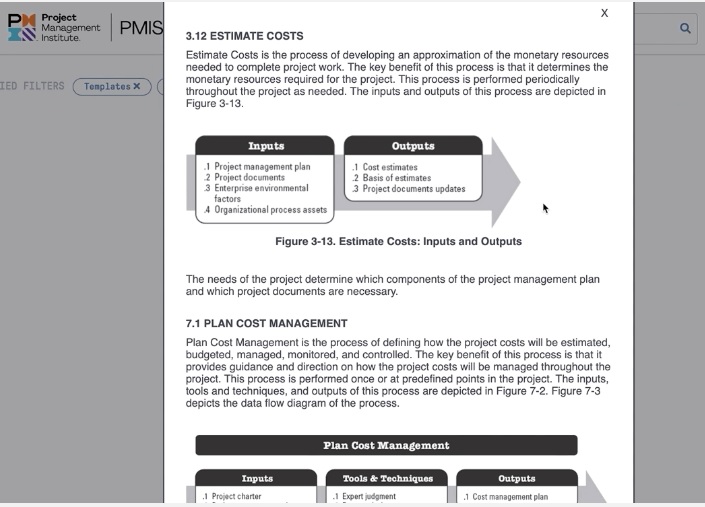
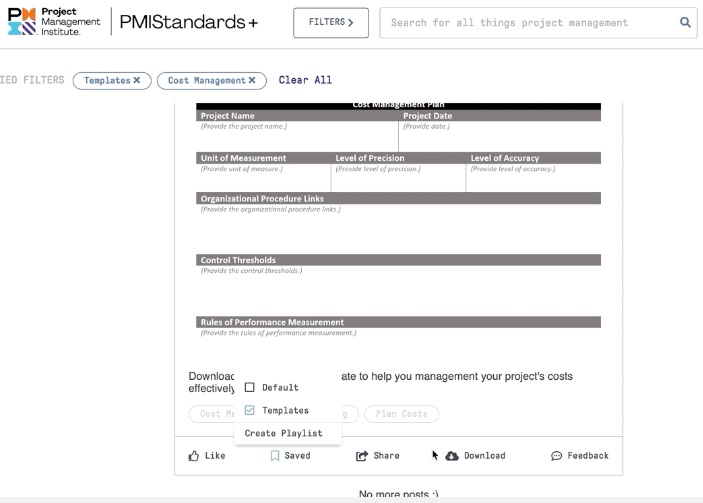

Comparison of table of contents for PMBOK 6th and 7th editions
Here is a summary of the differences in the table of contents between the 6th and 7th editions of PMBOK.
As mentioned above, the PMBOK 6th edition was organized into “the 10 Knowledge Areas” and “the 5 Process Groups (49 Processes),” but the 7th edition has been reorganized into “the 12 Principles” and “the 8 Project Performance Domains.”

Below are some books that provide detailed explanations of the contents of the 7th edition:
Below, I will introduce courses that provide comprehensive educational training, agile methods, and the revised PMBOK 7th edition.
udemy-PMBOK Guide 7: Everything You Need to Know

udemy-PMBOK Guide 7th Edition Masterclass (Agile & Hybrid Lectures

udemy-PMBOK Guide 7th Edition Review 18 PDU’s, Renew the PMP

Conclusion
Thank you for reading to the end.
Finally, I will summarize the differences between the 6th and 7th editions of PMBOK as below.
In my experience, the PMP certification I earned through studying PMBOK is one of the most useful certifications for work. I would be really happy if I could be of any help to you.
- What is PMBOK?
PMBOK is “the Project Management Body of Knowledge” and is a systematically organizes techniques and know-how related to project management. - What is the difference between PMBOK 6th & 7th edition?
- From Process-Based to Principle-Based
Rather than rigidly fixing the process as in the previous 6th edition and providing how-to instructions for each process, 7th edition clearly defines the areas in which performance can be demonstrated based on clearly defined principles, and by showing the specific activities and behavior of a project manager in each area, it can be said that it is organized in a way that allows it to flexibly respond to any type of project. - A new chapter dedicated to tailoring
In the 7th edition it has been expanded and consolidated into a chapter dedicated to tailoring. - Models, Methods, Artifacts and utilizing Digital Content Platform
The PMBOK 6th edition described the tools and techniques used in project management, including when (in which process group) and how to use them, but the 7th edition only introduces the models, methods, and products, and instructions on how to use them are published on a website (PMI standards+ Digital Content Platform).
- From Process-Based to Principle-Based
